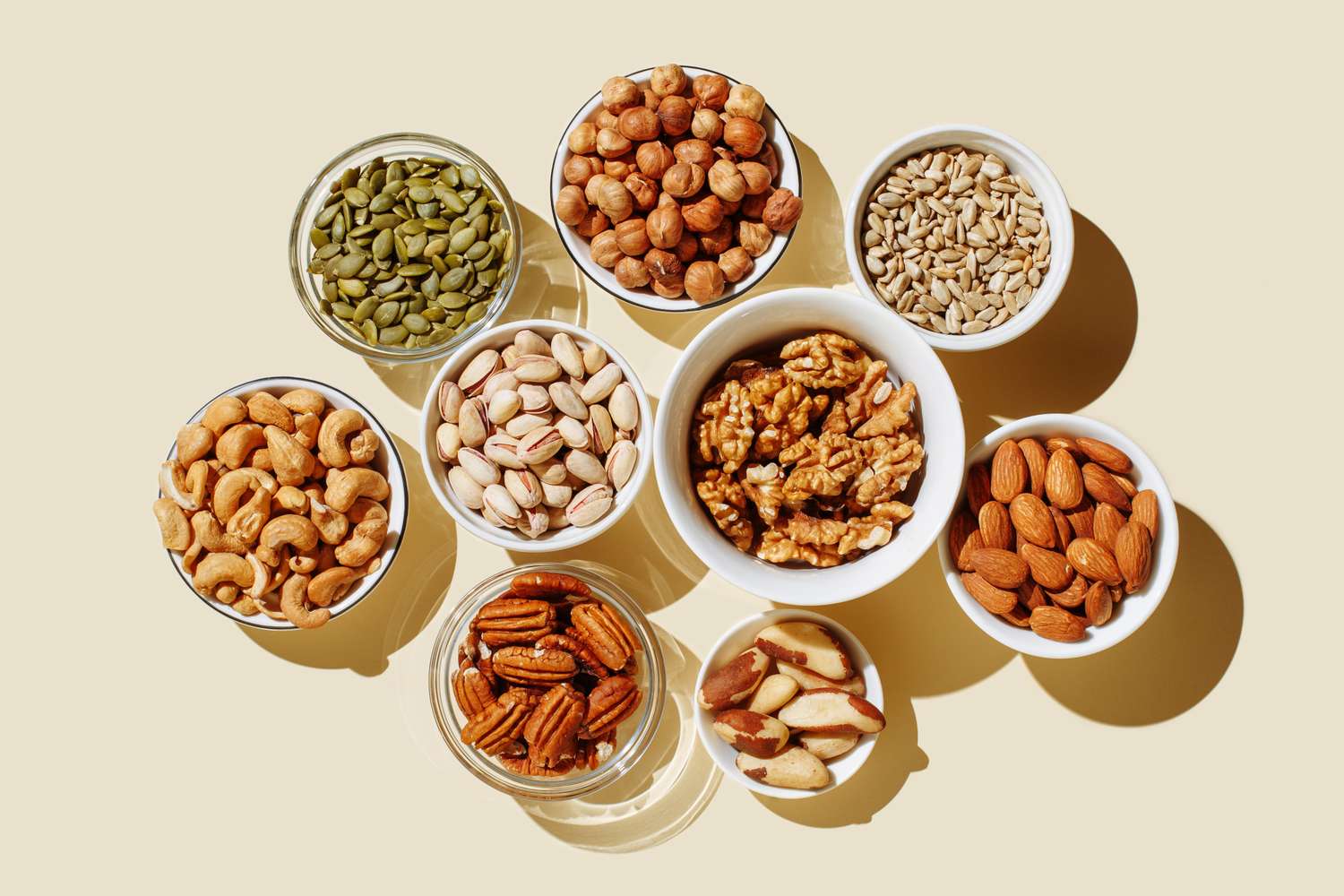Pumpkin and hemp seeds contain the most protein per ounce. However, eating nuts and seeds regularly can have other health benefits, including supporting healthy blood pressure, brain function, and blood sugar.
1. Pumpkin Seeds
bhofack2 / Getty Images
Serving size: 1 ozProtein: 9 g
Pumpkin seeds are a good source of protein, but they also contain tryptophan. Research suggests that they help improve your sleep quality. If you don’t like the taste of raw pumpkin seeds, you can toast them to change things up.
2. Hemp Seeds
Hemp seed hearts, or the shelled seed.
Getty Images
Serving size: 1 ozProtein: 9 g
Hemp seeds are high in protein and polyunsaturated fatty acids, including linoleic acid and alpha-linolenic acid. They also contain vitamins you need to stay healthy, including vitamin E, vitamin D, and vitamin A.
3. Peanuts
nilimage / Getty Images
Serving size: 1 ozProtein: 7 g
Peanuts are technically legumes, but are often lumped in with nuts, said Stephani Johnson, RDN, DCN, adjunct professor in the department of clinical and preventive nutrition services at the Rutgers School of Health Profession.
They also offer many health benefits outside of a protein boost. They contain phenolic acids, flavonoids, resveratrol, and phytosterols, which may improve cholesterol. They also contain amino acids linked to disease prevention and may promote longevity.
4. Almonds
MixitIstock / Getty Images
Serving size: 1 ozProtein: 6 g
“Among tree nuts, almonds and pistachios are the top protein sources,” Johnson said.
Almonds also contain fatty acids, lipids, amino acids, carbohydrates, vitamins, and minerals. Research has shown that consumption of almonds has been linked to improved cardiovascular and gut health.
5. Pistachios
everydayplus / Getty Images
Serving size: 1 ozProtein: 6 g
Aside from protein, pistachios are a significant source of:
PotassiumVitamin EVitamin KMagnesiumIronZincSeleniumFolate
Adding pistachios to your diet may decrease inflammation. Pistachios also contain antioxidants.
“Diets high in antioxidants are associated with a lower risk of chronic diseases, including heart disease, diabetes, and certain cancers,” Johnson said.
6. Sunflower Seeds
Enrique Díaz/7cero/Getty
Serving size: 1 ozProtein: 6 g
In addition to being a good source of protein, sunflower seeds contain antimicrobial, anti-inflammatory, and antihypertensive properties. They also contain antioxidants and provide cardiovascular benefits.
7. Cashews
Cashew nuts in a clear glass bowl.
Huizeng Hu / Getty Images
Serving size: 1 ozProtein: 5 g
Cashews have been shown to improve cholesterol. One study found that adding cashews to your daily diet could lower both total cholesterol and low-density lipoprotein (LDL) “bad” cholesterol.
8. Chia Seeds
Regularly eating chia seeds can support your skin health.
Elena Fedorina / Getty Images
Serving size: 1 ozProtein: 5 g
Chia seeds are a great addition to many dishes, but it’s important to note that you shouldn’t eat them dry. If you don’t mix them with wet ingredients, be sure to soak them before consumption to avoid choking or gastrointestinal discomfort.
“In addition to providing protein, chia seeds are rich in omega-3 fatty acids, which are associated with improved cardiovascular health, including lower LDL cholesterol and triglyceride levels and higher HDL cholesterol levels,” Johnson said.
9. Flaxseeds
Svittlana / Getty Images
Serving size: 1 ozProtein: 5 g
Johnson said that flaxseeds are also a good source of omega-3 fatty acids.
Eating flax seeds regularly has been linked with improved cholesterol. Research suggests that flaxseed may also lower your risk of cardiovascular disease.
How to Add More Nuts and Seeds to Your Diet
You can add nuts and seeds to your favorite dishes throughout the day.
“At breakfast, nuts and seeds add texture and nutrition when sprinkled over yogurt, oatmeal, or cereal,” Johnson said. “Chia seed pudding is currently a popular option, offering a nutrient-dense, fiber-rich start to the day, while overnight oats provide a neutral base that pairs well with any nut or seed topping.”
Johnson said that if you often eat salad at lunch or dinner, consider adding pumpkin seeds, sunflower seeds, or almonds to your mix.
“Finely chopped nuts can add crunch or flavor to a breadcrumb coating for chicken or fish,” she added. “They can also elevate vegetable dishes—for example, roasted pistachios combined with browned butter make a flavorful topping for roasted winter squash.”
Nut butters can also be helpful if you want to eat more protein. “They can be blended into smoothies, paired with fruit or whole-grain crackers, incorporated into baked goods, or used in savory dishes such as Asian-style peanut noodles or chicken satay dipping sauce,” Johnson said.

